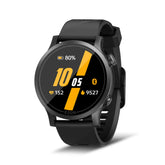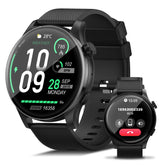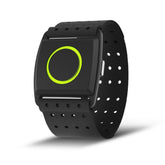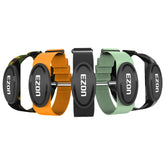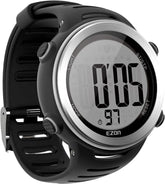10K Training Edge: Step and Heartbeat Tracking for Faster Times
Running a faster 10K isn’t just about logging miles—it’s about training with precision. By combining step count and heartbeat tracking, you’ll analyze performance analysis like a pro, adjusting intensity, form, and recovery to smash race times. This guide reveals how data turns good training into great results—no guesswork, just strategic progress.
1. The 10K Performance Equation: Steps + Heart Rate = Speed
A. Step Count: The Foundation of Consistency
- Daily Step Goal: Build to 10,000–12,000 steps/day (includes warm-ups, cool-downs, and daily activity) to boost non-exercise calorie burn (NEAT).
- Cadence Control: Aim for 170–180 steps/minute to reduce knee impact—use your watch’s real-time cadence alerts to maintain turnover.
B. Heartbeat Tracking: Train in Your Sweet Spot
-
5 Heart Rate Zones for 10K:
- Zone 2 (60–70% MHR): 60% of runs for aerobic base (e.g., 45-minute easy jogs).
- Zone 3 (70–80% MHR): 30% of runs for tempo efforts (race-specific stamina).
- Zone 4 (80–90% MHR): 10% of runs for intervals (speed development).
- Pro Tip: Use a heartbeat tracking watch to ensure tempo runs stay in Zone 3—overstepping into Zone 4 too early leads to burnout.
2. 12-Week Training Plan: From Good to Great
Phase 1: Base Building (Weeks 1–4)
- Goal: Build endurance and perfect form.
-
Key Workouts:
- Easy Runs: 30–40 minutes at Zone 2, focusing on midfoot strike and relaxed shoulders.
- Stride Drills: 10-minute post-run high knees/butt kicks to improve neuromuscular coordination.
- Step Count Focus: Gradually increase weekly steps by 10% (e.g., 30,000 steps → 33,000 steps) to avoid injury.
Phase 2: Intensity & Tempo (Weeks 5–8)
- Goal: Introduce race-specific intensity.
-
Key Workouts:
- Tempo Runs: 2x15 minutes at 75% MHR (10K goal pace + 15 seconds/km), using watch pace alerts to stay on track.
- Fartlek Training: 45-minute run with 1-minute fast bursts (Zone 4) + 2-minute recovery—let your watch auto-detect effort changes.
- Heartbeat Insight: Post-workout, heart rate should drop 20 BPM/min—slower recovery means add an extra rest day.
Phase 3: Peak & Taper (Weeks 9–12)
-
Peak Week (Week 10):
- 10K Simulation Run: 10K at goal pace, analyzing step count (should be 17,000–18,000 steps for 5:00/km pace).
- Interval Session: 8x400m at 85% MHR with 90-second jog recovery, focusing on quick turnover.
-
Taper (Weeks 11–12):
- Step Reduction: 30% weekly decrease (e.g., 50,000 steps → 35,000 steps) while maintaining intensity.
3. Performance Analysis: Turn Data into Action
A. Post-Run Data Review
- Step Symmetry: Aim for <5% difference in left/right step count—imbalance signals muscle weakness (e.g., glute activation drills to correct).
- Heart Rate Variability (HRV): High HRV means your body can handle more intensity; low HRV (below 40) calls for yoga or walking.
B. Race Pace Calibration
-
Goal Pace Calculation:
- 5K PR = 20 minutes → 10K goal pace = 4:12/km (add 12 seconds/km to 5K pace).
- Use your watch’s race predictor feature (if available) to validate estimates.
C. Form Optimization
- Vertical Oscillation: Keep below 10cm to reduce energy waste—excessive bounce is visible in accelerometer data.
- Stride Length: Pair step count with GPS to calculate stride length (ideal: 1.2–1.8m, depending on height) and adjust for efficiency.
4. Recovery: The Unsung Hero of Speed
A. Active Recovery with Data
- Rest Days: 1–2 days/week of walking or cycling at Zone 1 (50–60% MHR), logging 5,000–7,000 steps to maintain circulation.
- Sleep Tracking: Ensure 7–9 hours/night, with 15% deep sleep for muscle repair—use your watch’s sleep staging to adjust bedtime (e.g., 10 PM lights-out for 7:30 AM wake-up).
B. Overtraining Prevention
- Resting Heart Rate (RHR): A 5 BPM increase from baseline signals fatigue—swap a hard run for stretching and hydration.
- Step Count Limit: Cap daily steps at 15,000 during peak weeks to avoid cumulative stress on joints.
5. Gear Up for 10K Success
A. Step Count Watch Features
- GPS Accuracy: Multi-band GPS (GPS + GLONASS) for precise route tracking, especially in urban areas (e.g., EZON GPS Series).
- Battery Life: 20+ hours in GPS mode for long training runs and race day—no mid-run charging needed.
B. Heartbeat Tracking Essentials
- Wrist-Based Precision: EZON Heart Rate Series for 24/7 monitoring, including during high-intensity intervals.
- Real-Time Alerts: Customize vibration alerts for pace, heart rate, and cadence to stay on target without glancing at your watch.
C. Race-Day Gear
- Lightweight Shoes: Test in training to avoid blisters (replace every 300 miles).
- Nutrition Plan: Program gel alerts (every 4K) on your watch to ensure 30g carbs/hour for sustained energy.
6. Common Mistakes to Avoid
-
Ignoring Step Count Consistency:
- Solution: Use a step count watch to build a “step streak” (7 consecutive days of 10,000+ steps) for motivation.
-
Overtraining in Higher Zones:
- Solution: Keep 80% of runs in Zone 1–2—heartbeat tracking ensures you’re not overworking your aerobic system.
-
Neglecting Post-Run Analysis:
- Solution: Spend 5 minutes post-run reviewing step count, heart rate, and cadence to identify trends (e.g., slower recovery on hilly routes).
7. Sample Weekly Training Schedule (Weeks 5–8)
| Day | Activity | Data Focus |
|---|---|---|
| Monday | Easy Run (40 mins, Zone 2) | Monitor cadence (175 steps/min) |
| Tuesday | Tempo Run (2x15 mins, Zone 3) | Heart rate stability (±5 BPM) |
| Wednesday | Cross-Training + Core | Step count (5,000 steps) |
| Thursday | Fartlek Training (45 mins) | Effort distribution (Zone 4 bursts) |
| Friday | Rest or Yoga | RHR and HRV check |
| Saturday | Long Run (60 mins, Zone 2) | Step count (12,000 steps) |
| Sunday | Form Drills + Recovery Walk | Stride symmetry (<5% imbalance) |
8. FAQs: Your 10K Data Questions Answered
Q: How do I choose between step count and pace?
- Prioritize cadence (steps/min) for injury prevention and pace for speed—use your watch to track both simultaneously.
Q: Can I improve my 10K time without running faster?
- Yes! Increase cadence by 5 steps/min (e.g., 170 → 175) to run more efficiently—no extra effort needed.
Q: What’s the best way to use heartbeat tracking during a race?
- Focus on keeping heart rate in Zone 3 for the first 8K, then allow it to rise to Zone 4 for the final 2K surge—let your watch’s real-time data be your guide.
Train with Data, Race with Confidence
With step count and heartbeat tracking as your training partners, every run becomes a lesson in progress. Use data to refine form, adjust intensity, and honor recovery, and you’ll cross the finish line not just faster, but stronger and smarter.
The 10K is a race of strategy and stamina—let technology be the edge that turns your goals into reality. Gear up, track wisely, and let every step and heartbeat bring you closer to that PR. The starting line is just the beginning—your data-driven training has already won half the battle.
EZON Watch: Professional sports technology brand
https://ezonwatch.com
https://ezonwatch.com
